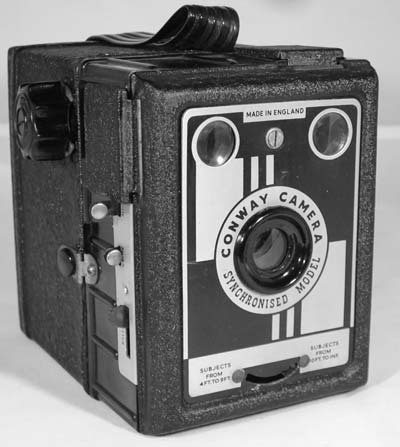Standard Conway Synchronised
Specification

| Manufacturer | : | Standard |
|---|---|---|
| Produced | : | 1952 |
| Classification | : | Medium Format |
| Body Type | : | Box |
| Construction | : | Metal/Bakelite |
| Film Type | : | 120 |
| Film Width | : | 62mm |
| Image Size | : | 2¼ x 3¼ in |
| No. of Images | : | 8 |
| Focal Length | : | 110mm |
| Lens Type | : | Meniscus |
| Focus Type | : | Fixed plus Close-up lens |
| Focus Range | : | 10ft to inf. plus Close-up (4-9ft) |
| Aperture Type | : | Fixed plus green filter |
| Aperture | : | f/14 |
| Shutter Type | : | Rotary |
| Shutter Speeds | : | B, I*(1/35 sec) |
| Size (w x h x d) | : | 95 x 110 x 120 mm |
| Weight | : | 474g |
| * Measured on this camera | ||
Art Deco Credentials
![]()
![]()
Acceptable: Modest and restricted
- Produced after the main Art Deco period;
- Art Deco geometric pattern on front plate;
- Reflective symmetry on front plate
- Ribbed Bakelite body front;
- Ribbed plastic strap handle
Description
The Standard Conway Synchronised camera looks almost identical to the Coronet Captain box camera except for the facia. Standard Cameras had close links with Coronet Cameras who were both subsidiaries of Dufay-Chromex, colour photograph specialists. There are differences internally as the Conway has a flat film plane whereas in the Captain it is curved. It uses rollfilm No.120 and is a simple box camera designed for capturing 6 x 9 cm pictures. It is constructed in two parts. The front is made from ribbed Bakelite with a decorative metal front plate. The rear is a metal box. It features black hinged viewfinder covers over two brilliant finders for landscape or portrait photos. It has a nice ribbed plastic strap.
It has a fixed focus meniscus lens. Shutter has two settings: instant or time. There is a tab to pull to switch between instant and time exposures. The film advance is not coupled to the shutter release so double exposure is possible. A built in green filter can be pulled into place by a lever on the side. The green filter can be used for photographing plants, separating the green foliage from the brightly-coloured flowers. It can also be used in landscape photography to boost the appearance of grass and trees. There is a two position sliding lever below the lens that controls the focus. In one position, focus is between 4ft and 9ft whilst in the other the focus goes between 10ft and infinity. This model has synchronised flash connectors on the side.
How to Use
This camera takes 120 film which is easily available.
As the shutter speed is only 1/35s, it is advisable to use a tripod to get clear shake free images. However, holding it against a wall or other solid object would work as well. For quick snapshots, hold it firmly against your body.
If you don't want to bother with an exposure meter, follow the guide shown. It is based on the 'Sunny 16' rule. Film is so forgiving and will produce acceptable results even when overexposed by 2 or 3 stops or underexposed by 1 stop.
The tables assume that the sun is at least 30 degrees above the horizon - that's 10am - 5pm on a summers day (May - August) in the UK.
Remember that the exposure guide in the manual may not be helpful as it is based on the use of old film with a low ISO value.
Using ISO 100/125 film - shutter speed 1/35s
| Weather Conditions | Shadow Detail | Aperture | Exposure |
|---|---|---|---|
 Sunny SunnySnow/Sand | Dark with sharp edges | f/14 | +3 Stops Overexposed Acceptable |
 Sunny Sunny | Distinct | f/14 | +2 Stop Overexposed Acceptable |
 Slight Overcast Slight Overcast | Soft around edges | f/14 | +1 Stop Overexposed Acceptable |
 Overcast Overcast | Barely visible | f/14 | Good |
 Heavy Overcast Heavy Overcast | None | f/14 | -1 Stop Underexposed Acceptable |
 Open Shade Open Shade/Sunset | None | f/14 | -2 Stops Underexposed Not Acceptable |